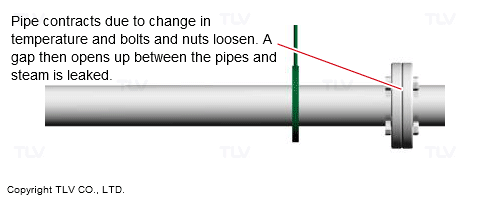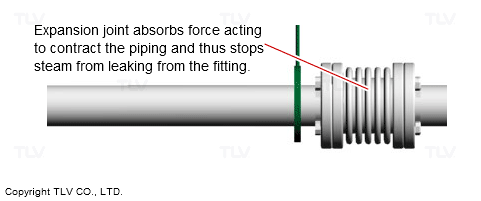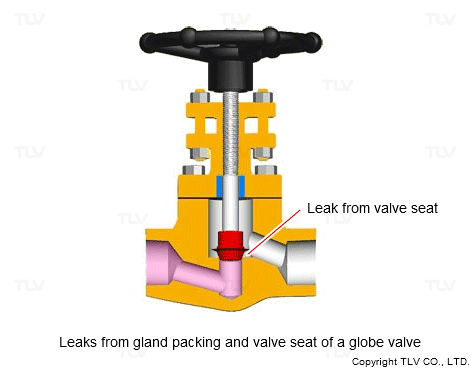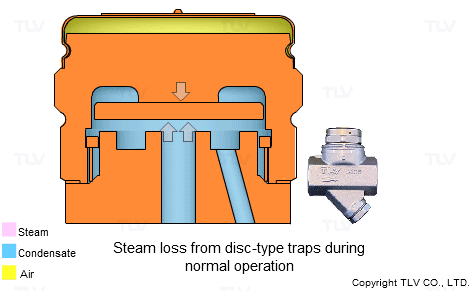- Home
- Steam Resources
- Steam Theory
- Preventing Steam Leaks
Energy Efficiency
Preventing Steam Leaks
Locations of Steam Leaks
In plants that have been constructed to consume as little energy as possible, it is rare to find steam leaking from pipes and valves. However, even in such plants, steam will start to leak after a few years as gaskets, fittings, and other areas age, unless these areas are regularly inspected and maintained. Without proper maintenance, the number of leaks and the volume of leaked steam will only increase.
The locations where steam leaks are most commonly found are:
- Pipe fittings
- Valves
- Steam traps
Leaks from valves and steam traps can be further divided into external leaks, such as those from gland packing, and internal leaks, where steam escapes through the seat and into the outlet.
Preventing Leaks From Pipe Fittings
The main causes of steam leaks from pipe/valve flanged and screwed connectors are: (1) stress from pipes expanding or contracting due to the heat of the steam, (2) threaded components that have loosened due to that stress, and (3) deterioration of gaskets.
When pipes contract due to a drop in the temperature of the steam, the nuts and bolts of the fitting can loosen, causing a gap to open up between the two pipes from which steam will escape.
If plant workers find a steam leak, they should do more than simply tighten the screws on the fitting or replace the gaskets. They should also investigate the cause of the leak and consider changing the number and location of fixed pipe supports or adding expansion joints. If countermeasures such as these are not taken, it is likely that the leak will reemerge in the future.


Increasingly, plants are choosing to install stainless steel piping, but stainless steel piping is more susceptible to expansion and contraction due to steam temperature than carbon steel piping. Care should be taken to install the fittings of stainless steel piping tighter than for carbon steel piping.
Preventing Leaks From Valves
The vast majority of external leaks from valves come from gland packing. Due to the construction of valves, gland leaks can be stopped temporarily by tightening the valve.
However, in locations where the valve is opened and closed regularly, it is likely to start leaking again within a short timeframe. A bellows seal valve is recommended in such locations. Bellows seal valves are highly resistant to gland leakage because of their bellows, which closes off the interior and exterior gland packing.
Interior leakage occurs when steam escapes (often through the valve seat) and flows through the outlet while the valve is in the "closed" position. Interior leaks cannot be seen from the outside, and so are difficult to spot. To find interior leaks, use a maintenance tool such as a stethoscope or a device that measures ultrasonic vibrations.

It is common for steam to leak from the seat of valves with both adjustable and closable valve openings. One way of preventing this is to use adjustable and closable valves where necessary, eliminating the need for dual-function valves. However, another effective method of preventing internal leaks is to install a separator to remove the condensate entrained within steam. Supplying dry steam will prevent the valve seat from deteriorating.
Preventing Leaks From Steam Traps
For valves and pipe fittings, leaks occur when the device stops functioning correctly, but for steam traps, we must also consider the loss of steam that occurs during normal operation.
Steam Losses During Normal Operation
The amount of steam that leaks from a steam trap during normal operation varies depending on the type of trap. When new, a disc trap can leak up to 10 times the volume of steam compared to an energy-efficient Free Float® trap, depending on steam pressure and condensate volume.

For this reason, TLV recommends selecting Free Float® traps to reduce steam loss during normal operation.
Leaks From Failed Traps
As shown in Steam Line Energy Saving Tips, the steam that leaks from even one failed trap can represent a significant financial loss.
Data from TLV's steam trap assessments shows that, prior to assessment, an average of 5-10% of all steam traps in plants leaked steam. By identifying leaking traps and swapping them with energy-efficient Free Float® traps, plants can achieve significant energy savings.
To schedule an assessment of the pipes, valves, and steam traps in your plant, contact TLV today:

